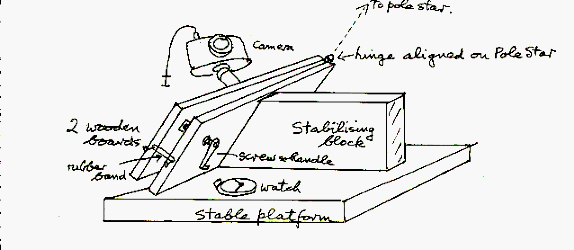The Scotch Mount (Reprinted from SAG Mag)

Also known as the Haig Mount, this useful device is already known to many readers of SAGMag. For those who have not yet met it, Dave Gavine expounds on its merits.
This simple device for taking photographs of star fields is attributed to George Haig, an ingenious maker of astronomical machines made out of unlikely materials such as wood, cardboard and cotton reels. He was a lecturer in Physics at Paisley Technical College (now University) where he had his own home-made Planetarium; he now lives in retirement in Bridge of Weir.
The machine is useful for photographing star-fields and comets, with exposure of up to 5 minutes, with 50mm or wide-angle lenses. Beyond about 10 minutes there is usually a little star-trailing visible, and it becomes fatiguing. The camera should be set at f/2.8 or f/4; if the lens is open further there is usually coma at the edges of the field, and you will also pick up reflected light pollution such as the sodium haze.
Practice will soon indicate the best combination of exposure time and aperture. If, like me, you live in or close to a big town with its light problems, you may find a filter useful, such as a neodymium type to eliminate the sodium (from the older, low-pressure street-lights, but alas ineffective with the high-pressure ones), or even a pale blue one.
The "magic number" for building the Haig Mount is 229. That is, the distance from the centre of the screw to the hinge-line is 229 times the pitch of the screw thread. The pitch is best obtained by measuring the length of the screw in millimetres, then dividing by the total number of threads in that distance.

Why 229? The screw must be turned steadily at a rate of one turn per minute. Each turn moves the board carrying the camera through a small angle arcsin(1/229) = 0.2502 degrees.
Therefore in one sidereal day of 23h 56m, or 1436 minutes, the number of degrees turned would be 359.3 - near enough 360.
So this ratio drives the camera at the correct sidereal rate to counteract the Earth's spin. In practice, of course, the screw is linear, not the arc of a circle, so after about 10 minutes the true rate wanders off and errors creep in.
Set up the mount on a stable, flat base, and align the hinge-line on the Pole Star. (This is not quite the true Celestial Pole, but for short exposures it will do.) I have two small white-painted staples as sights to do this, and I use a small mirror, for it is awkward trying to squint up the hinge. I have leveling screws on my wooden base for this adjustment - also useful if I take it to a different latitude. Firmly secure the machine with elasticated cycle straps, and set the camera on the star-field. Make sure it is set at "B", f/2.8 (or whatever), and infinity; use a cable- release and a lens-hood. To eliminate camera shake, use a black hat or similar object to cover the lens before firing the shutter. Although some books suggest turning the screw (with the aid of a small handle) once at the end of each minute, it is much better to turn it continuously and carefully, following the second-hand of a watch.
These simple instructions should give you good results. Best films to use are Ektachrome 200 or 400, or Fuji in the same range; but do experiment. Even slow slide films will give you something. Print film is seldom successful - the printers don't appreciate star pictures.
For further advice, see Astrophotography - An Introduction by H J P Arnold, Philips Observer's Handbook, 1998, ISBN 0-540-06086-0.